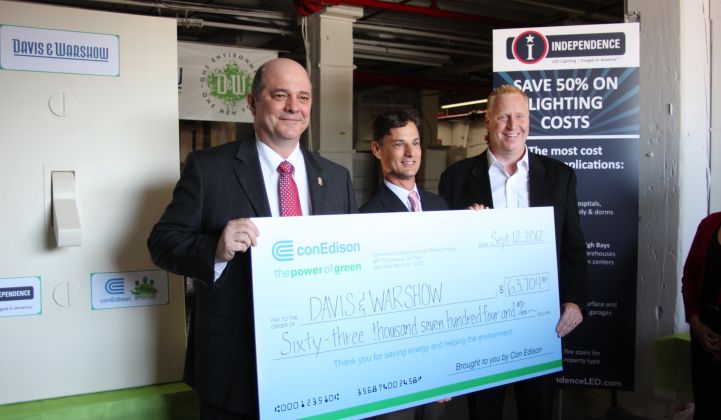Four years ago, when Consolidated Edison was designing its commercial and industrial rebate programs, LEDs weren’t mature enough to make it into the prescriptive program. Instead, solid-state lighting was lumped in with the custom rebate program.
When the programs are redesigned next year, some LEDs will probably move out of the custom category. “In the past few years, the LEDs have come on fast,” said David Pospisil, program manager of the Con Edison Commercial & Industrial Energy Efficiency Programs.
Many companies are looking to their utilities to provide rebates for LED retrofits, which offer a huge energy savings but can still come with a significant upfront cost -- despite falling prices. Davis & Warshow, a nearly 90-year-old family business in ConEd’s territory, recently spent more than $250,000 to retrofit its Queens distribution center from fluorescent tubes to LED tubes from Independence LED.
The retrofit was the largest single-facility LED tube installation with the most energy efficiency lighting in watts per square foot to date, according to ConEd. Before the switch, lighting ate up nearly 65 percent of the building’s total power usage, costing nearly $50,000 per year. Now that figure is less than $20,000, about 60 percent lower.
The retrofit was possible in part to ConEd’s commercial and industrial rebate program, which gave Davis & Warshow a rebate check for $63,704. The project is expected to have a five-year payback. The company, based in Maspeth, NY, also has a rooftop solar array that puts out more than 200,000 kilowatt-hours annually, which makes the new lighting system net-zero.
ConEd is not alone in treading lightly into shifting LEDs from custom rebate programs to prescriptive programs. Utilities across the country show limited prescriptive rebate support for LED lighting, according to a report by Groom Energy and GTM Research, Enterprise LED 2012: Commercial and Industrial Market Trends, Opportunities and Leading Companies. But that is changing.
New York is second only to California in dollars spent by utilities in energy efficiency rebate incentive programs. In 2008, there was about $3.1 billion in total U.S. rebate dollars, with the money concentrated in ten states. The figures are expected to more than double in coming years, with $7.4 billion to $12.4 billion available by 2020.
As the LED market matures, utilities will aggressively start moving. “When satisfied that savings can be successfully achieved, utility program managers will typically authorize custom rebate amounts up to 50 percent of the entire cost of the project, as opposed to a prescriptive rebate for each fixture,” the report authors wrote.
ConEd falls squarely into this category. The utility, which serves New York City and some surrounding areas, is seeing a booming demand for LED lighting, but is still waiting for more standards. The report notes that other Northeast utilities, including National Grid and NStar, are some of the most progressive, offering prescriptive rebate programs for a range of LED lighting applications.
Commercial customers look to the utilities to be a trustworthy source when it comes to picking new products, which is why so many utilities are wading carefully into the world of LEDs. “There are a lot of products that are substandard, and it’s hard for customers to separate products,” said ConEd’s Pospisil. Inclusion on the Design Lights Consortium-approved product list has moved to being the key criterion for most utilities, according to the Groom report. Rather than creating a standard, DLC is a group of utilities and energy efficiency groups that approve lighting products.
While utilities don’t want to back the wrong horse, they also don’t want to miss out on the growing interest in LED retrofits. ConEd has $50 million per year to spend through the end of 2015 on C&I rebate programs total.
California, New York, Florida and Massachusetts have some of the most robust energy efficiency programs, but others, like Pennsylvania, Illinois, Arizona and Ohio, have started building new programs entirely, according to the Consortium for Energy Efficiency. North Carolina and Michigan are also increasing spending, according to Lawrence Berkeley National Laboratory.
The falling cost of LEDs is a driver for the interest on the part of customers, but it is only one piece of the puzzle, according to Jon Guerster, CEO of Groom Energy. Even if states that are new to the game aren’t putting in as much money as California, for instance, the increased utility funds will help push LEDs into the commercial and industrial mainstream.
“The answer is not just that this is cheaper,” he said. “Our customers say, ‘LEDs are here and they’re still expensive, but I have to be thinking about it.’ That’s a massive shift.”



